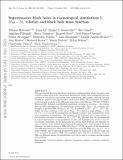Supermassive black holes in cosmological simulations I: M BH − M ⋆ relation and black hole mass function
Author(s)
Habouzit, Mélanie; Li, Yuan; Somerville, Rachel S; Genel, Shy; Pillepich, Annalisa; Volonteri, Marta; Davé, Romeel; Rosas-Guevara, Yetli; McAlpine, Stuart; Peirani, Sébastien; Hernquist, Lars; Anglés-Alcázar, Daniel; Reines, Amy; Bower, Richard; Dubois, Yohan; Nelson, Dylan; Pichon, Christophe; Vogelsberger, Mark; ... Show more Show less
DownloadAccepted version (4.818Mb)
Open Access Policy
Open Access Policy
Creative Commons Attribution-Noncommercial-Share Alike
Terms of use
Metadata
Show full item recordAbstract
The past decade has seen significant progress in understanding galaxy formation and evolution using large-scale cosmological simulations. While these simulations produce galaxies in overall good agreement with observations, they employ different sub-grid models for galaxies and supermassive black holes (BHs). We investigate the impact of the sub-grid models on the BH mass properties of the Illustris, TNG100, TNG300, Horizon-AGN, EAGLE, and SIMBA simulations, focusing on the MBH − M⋆ relation and the BH mass function. All simulations predict tight MBH − M⋆ relations, and struggle to produce BHs of $M_{\rm BH}\leqslant 10^{7.5}\, \rm M_{\odot }$ in galaxies of $M_{\star }\sim 10^{10.5}\!-\!10^{11.5}\, \rm M_{\odot }$. While the time evolution of the mean MBH − M⋆ relation is mild ($\rm \Delta M_{\rm BH}\leqslant 1\, dex$ for 0 $\leqslant z \leqslant$ 5) for all the simulations, its linearity (shape) and normalization varies from simulation to simulation. The strength of SN feedback has a large impact on the linearity and time evolution for $M_{\star }\leqslant 10^{10.5}\, \rm M_{\odot }$. We find that the low-mass end is a good discriminant of the simulation models, and highlights the need for new observational constraints. At the high-mass end, strong AGN feedback can suppress the time evolution of the relation normalization. Compared with observations of the local Universe, we find an excess of BHs with $M_{\rm BH}\geqslant 10^{9}\, \rm M_{\odot }$ in most of the simulations. The BH mass function is dominated by efficiently accreting BHs ($\log _{10}\, f_{\rm Edd}\geqslant -2$) at high redshifts, and transitions progressively from the high-mass to the low-mass end to be governed by inactive BHs. The transition time and the contribution of active BHs are different among the simulations, and can be used to evaluate models against observations.</jats:p>
Date issued
2021Department
Massachusetts Institute of Technology. Department of Physics; MIT Kavli Institute for Astrophysics and Space ResearchJournal
Monthly Notices of the Royal Astronomical Society
Publisher
Oxford University Press (OUP)
Citation
Habouzit, Mélanie, Li, Yuan, Somerville, Rachel S, Genel, Shy, Pillepich, Annalisa et al. 2021. "Supermassive black holes in cosmological simulations I: M BH − M ⋆ relation and black hole mass function." Monthly Notices of the Royal Astronomical Society, 503 (2).
Version: Author's final manuscript